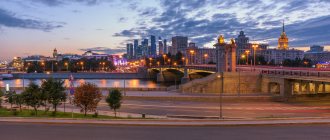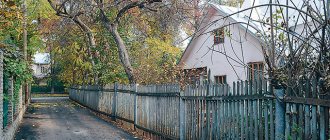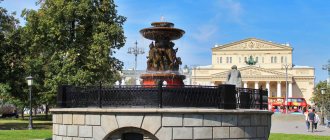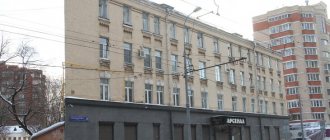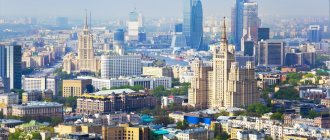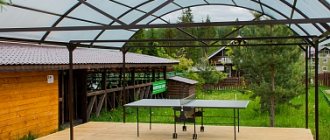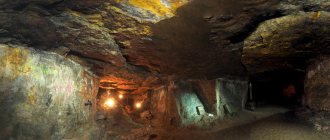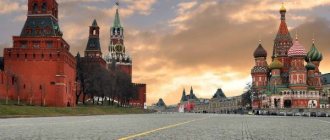Over the course of its rich thousand-year history, the capital has collected dozens of legends and ominous tales in its bins. Some of them are true, but some are simply fiction, born of rumors and wild popular imagination. Whatever the reality, the mysterious places of Moscow have always attracted and continue to attract the attention of tourists.
#1. Business center “Zenith”
Business center Zenit
“Zenith” or “blue tooth”, as it is popularly called, is an abandoned business center. The unofficial name “Blue Tooth” was given to the building because of its cladding with blue glass and the unusual shape of the building itself. In addition, the high-rise building is also called “Iceberg”, “Icy” or “Crystal”.
At the moment, the building is very dangerous: there are many unfinished elevator shafts, fittings everywhere and glass broken by vandals. Therefore, the business center is under 24-hour security. However, this does not prevent writers from constantly painting the walls here.
m. Yugo-Zapadnaya
Walk in the Dark Museum
Among the numerous Moscow museums, the inclusive museum “Walk in the Dark” stands out, the essence of which is fully reflected in the name. Visitors are invited to feel like they are in the shoes of a blind or visually impaired person (by the way, they are the ones holding the exhibition).
The museum's exhibition is divided into several rooms, which are decorated for different places: an ordinary apartment, a street, a cafe, a store. In absolute darkness, the visitor will have to perform various tasks, relying only on the remaining senses.
#2. Khovrinskaya hospital
Khovrinskaya Hospital
The construction of the Khovrinskaya hospital, which was supposed to be one of the best in Moscow, began in 1980 and was stopped after 5 years for unknown reasons. After construction ceased, the building began to attract many people, who gave the hospital several names: HZB, Howrinka and Umbrella. The latter was given by stalkers constantly trying to break into the building. The abandoned hospital is notorious. What they don't say about her. And that Satanists are operating in abandoned buildings, and that people are constantly disappearing here. Today the hospital is owned by the city of Moscow and in the uncertain future it is planned to build new buildings on its territory.
m. River Station
Hadron collider "Accelerator"
This unique structure, which has no analogues in Russia, is located in the city of nuclear physicists Protvino and is located at a depth of 60 meters. They started building it in the 80s, finished it by the 90s, but never brought it to fruition.
The fate of the collider is still being decided to this day - either to look for ways and means to finish what was started, or to dismantle it.
It should be noted that some scientists are strongly opposed to the resumption of construction: in their opinion, this could lead to irreversible consequences and a global environmental disaster.
Address: Simferopol highway, 97 km.
#3. School named after Zoya and Alexander Kosmodemyansky
School named after Kosodemyansky
In 1956, one of the capital’s schools was renamed the school named after Zoya and Alexander Kosmodemyansky, and the building was given the status of federal significance. After the building was declared unsafe, the school moved to a new building and the old building was abandoned. You need to walk here with great caution. The school suffered two fires. After the second, the roof of the building burned down and some of the ceilings collapsed. Inside the school there are still old furniture, textbooks, and a museum. Currently, they are planning to reconstruct the building, but the project deadlines are constantly being postponed.
m. Voykovskaya
#4. VIEV
VIEV
VIEV is the All-Russian Research Institute of Experimental Veterinary Medicine named after L.R. Kovalenko. The institute was organized in 1898 in St. Petersburg, then it was transported to the Kuzminki estate near Moscow. The institute building began to function in 1918, but in 2009 the institute had to move again. Today, the former building of the institute in Moscow is an old, dilapidated structure, ready to collapse at any moment. The so-called abandoned place in Moscow. According to those who have visited here, the greatest danger is not the building itself, but the exhibits. Since the institute conducted dangerous experiments on animals, dangerous chemicals and even the remains of the animals themselves remained here. The issue of disposal remains unclear. However, in the future they promise to demolish the building and check the area for chemical safety.
m. Lyublino
Sinister places in Moscow: Kuznetsky Bridge
It would seem - what frightening thing could be on the Kuznetsky Bridge? But they say that a ghost wanders along this street in the evening and at night, especially dangerous for journalists - a beautiful girl dressed in the fashion of the late 19th century. Don't let her get closer!
Anomalous places in Moscow. Kuznetsky Bridge. Photo: TASS
Urban legend says that this is the mistress of the philanthropist Savva Morozov named Zhuzhu. She once died on Kuznetsky Most Street due to the fault of a newspaperman. A lady was riding in a carriage and heard the shouts of a boy selling newspapers: “Read! Read! Savva Morozov committed suicide in Cannes!” Alarmed, Zhuzhu ordered to stop, got out and ran for the newspaper, but immediately fell under another carriage. The girl died immediately, but the newspaperman did not survive her for long. The boy was found strangled on the same street that same evening.
Since then, Zhuzhu has been hunting journalists, and meeting her at night on the Kuznetsky Bridge does not bode well. However, it’s better for everyone else not to see her either. For example, seeing the ghost of the Kuznetsky Bridge for a girl is a sign of an imminent separation from her lover.
#5. Water park “Aquadrome”
Water park Aquadrome
Water park “Aquadrome” was originally planned as a health complex. Construction stopped in 2000 due to investment problems and the building was abandoned. About half of the project was built, including the main pool, stairs, and many rooms. Today the building is in rather poor condition; in the spring the lower floors are flooded. This condition has caused several accidents. Nevertheless, the water park is a favorite place for parkourists, stalkers and homeless people. In the future, it is planned to demolish the building and erect a shopping and entertainment complex here. Although the timing has not been determined, the building has already begun to be demolished.
m. Kuntsevskaya
#6. “Escalator Gallery”
Escalator gallery
Before reconstruction, the Vorobyovy Gory metro station had two exits. One of them was supposed to become an escalator lift to the very top of the Sparrow Hills. However, the “Escalator Gallery” was never opened, and it is not known exactly why: some say it was due to lack of finances, some say it was because the facility was located in a dangerous area. The building itself is an intriguing place for many, albeit a little creepy and gloomy. Today the escalator is left to its own devices. Over more than 20 years of abandonment, the building has partially turned into ruins; almost all the walls are painted with graffiti or simply damaged by vandals, since the building is not guarded. There are no plans to reconstruct the building.
m. Vorobyovy Gory
Sinister places in Moscow: Igumnov's house
This architectural monument, made in pseudo-Russian style, is not just the most striking building on Bolshaya Yakimanka, but also a real house with ghosts. Let us remember that the former owner, the wealthy merchant Nikolai Igumnov, invited the Yaroslavl architect Nikolai Pozdeev to build the house. The construction of the mansion took more than a million rubles and five years of work, but the result absolutely did not fit into Moscow architecture. At that time, critics did not appreciate Pozdeev’s talent, calling the house too eclectic and massive.
Anomalous places in Moscow. Igumnov House (now the French embassy is located in this building). Photo: TASS
According to legend, the disappointed Igumnov refused to cover costs exceeding the estimate, and the architect found himself in a debt hole. Driven to despair, the creator of the mansion committed suicide (according to official data, he died of tuberculosis), before his death he cursed Igumnov’s house along with the owner.
Pozdeev’s curse apparently took its toll later - when Igumnov’s mistress, who lived in the mansion, was caught cheating. The merchant ordered the girl to be walled up alive in the wall. Now a sad beauty wanders through the halls of this palace in the evenings, emerging from one wall and disappearing into another. Again - according to legend.
#7. Plant named after Likhachev
ZIL
ZIL, the former AMO Automobile Plant, produced about 100,000 cars per year in the pre-war years and this figure was constantly growing. After the collapse of the USSR, production fell sharply, many workshops were abandoned. The territory of the plant is considered one of the largest in Moscow and is comparable to the area of the All-Russian Exhibition Center. The bulk of valuable items have long been removed, but you can still see various spare parts, materials and machines here. Currently, the company's management is trying to bring it out of the crisis. And by decree of the Moscow Government, the territory is being prepared for reconstruction.
m. Tulskaya
Snail's kiss
The next unread Moscow page is monuments. Monuments to Pushkin or Peter the Great are like relatives from the Tver region: you know everything about them, right down to snoring after a liter of homemade wine. Try to find this in Moscow. The monument to Sherlock Holmes and Doctor Watson (Smolenskaya embankment, 10) is a sculptural composition near the British Embassy building, which appeared on April 27, 2007, the event was timed to coincide with the 120th anniversary of the publication of Conan Doyle’s “A Study in Scarlet.”
The author Andrei Orlov “based” the appearance of the sculptures on the images created by the artist Sidney Paget, the first illustrator of the adventures of Sherlock Holmes , but in the faces and figures one can discern a resemblance to Vasily Livanov and Vitaly Solomin , who brilliantly played these characters in Russian films (English critics, you remember, they called them the best Holmes and Watson in world cinema).
The monument to guard Uncle Styopa (Slesarny Lane, 1) from the famous poem by Sergei Mikhalkov stands in front of the building of the Moscow Region Traffic Police Department not far from Mira Avenue (sculptor - Alexander Rozhnikov , cast at the Khimki Art Works Plant). At first, there were supposed to be two more admiring children’s figures near the monument, but in the end only the bird was left - bronze Uncle Styopa, according to the original poem, helps her get out of the traffic light. There is a sign - if you hold Uncle Styopa by the right (make sure not to mix it up!) trouser leg, the police will not stop you or fine you for a year.
Article on the topic
Bosyatskaya Sloboda. History of the main Khitrovsky shelters
Two more monuments for passionate romantics - firstly, a sculpture of a dancer on a pole near the Alekseevskaya metro station (Mira Avenue, 116), 100 meters from the famous strip club, and a difficult-to-reach due to its remoteness, but incredibly cute monument to snails in love in Kurkine (metro station "Planernaya", Solovinaya Roshcha str., 2). Sculptor Philip Rukavishnikov , son of the famous Alexander Rukavishnikov , is said to have been inspired by the “bed scene” of love between snails in the famous French film Microcosmos (although it must be borne in mind that snails for the most part are hermaphrodites, that is, both fathers and mothers rolled into one with horns, so their love is extremely unusual!). Newlyweds even from the center come to this love-snail monument!
#8. Zaryadye
Zaryadye
Historical area between Varvarka Street and the Moscow River, devastated 80 years ago. Previously, there were shopping arcades and shops here, merchants and artisans lived here. In the 1930s, massive demolition of buildings in Zaryadye began, including the demolition of most of the Kitay-Gorod wall. The construction of various buildings was planned many times on the territory of Zaryadye; as a result, in the 1930s, the Rossiya Hotel was built here, which was demolished relatively recently. Now Zaryadye is the largest wasteland in the heart of Moscow. Very soon the main park of the capital will appear here, built according to the designs of the winners of the competition to develop the architectural concept of the future park.
m. Kitay-Gorod
Tags abandoned
